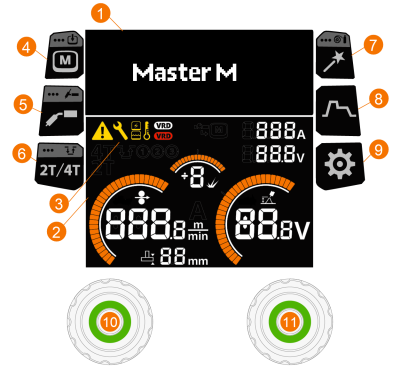Using control panel
The Master M control panel includes features and functions for MIG welding with the options to use Master M also for TIG and MMA welding.

General
| 1. | Settings display |
| 2. | Welding display |
| 3. | Indicators (for descriptions of the symbols, refer to the Indicators table below) |
| 4. | Memory channels button (MIG only) |
>> Shortcut to the memory channel selection
>> Long-press (> 1 second) opens a dialog for saving changed welding parameters to a memory channel
>> Memory channel selection is not available with TIG and MMA welding processes as there is one memory channel for each process
| 5. | Welding process / operation mode button |
>> Shortcut to welding process selection
>> Long-press (> 1 second) opens a dialog for switching between MIG / TIG / MMA modes
| 6. | Trigger logic button |
>> Switches between 2T and 4T trigger logic
>> Long-press (> 1 second ) opens the Powerlog settings (4T only). Powerlog trigger logic is not available with manual MIG and MAX Cool processes.
| 7. | Weld Assist button |
>> Shortcut to Weld Assist
>> Long-press (> 1 second) opens the filler wire and shielding gas settings adjustment required for using the 1-MIG process
| 8. | Welding parameters button |
>> Shortcut to the welding parameters view
| 9. | Settings button |
>> Shortcut to the system settings view
| 10. | Left control knob |
>> Adjustment and selection
>> Long press of the control knob button activates the wire inch function. The wire feed speed can be adjusted by turning the control knob. The wire inch function is automatically switched off when the function is not used for a while or when welding is started.
| 11. | Right control knob |
>> Adjustment and selection.
Indicators
| Symbol | Description |
|---|---|

|
General notification There is a problem that requires attention. |

|
Service / repair |

|
Power source |

|
Cooling unit |

|
High temperature indicator (overheating) |

|
VRD (Voltage Reduction Device): White VRD symbol is on = VRD is on Red VRD symbol is blinking = There is a fault with VRD that prevents welding. |
Views
| A. | Main view |
| B. | Memory channels |
| C. | Welding processes |
| D. | Welding parameters |
| E. | Trigger logic |
| F. | Weld Assist |
| G. | Weld data |
| H. | System settings |
| Tip: Use the online instruction's search feature at the top of the page to find more information on functions and features. |
